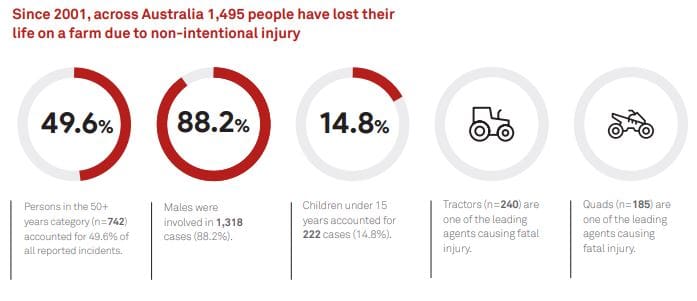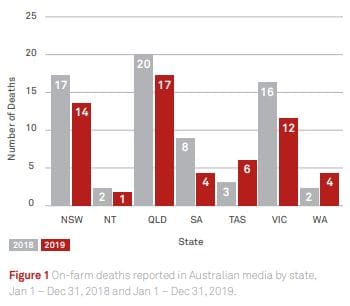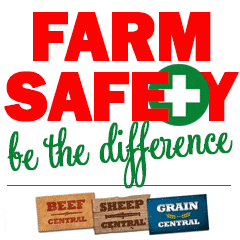Latest listings on Jobs Central recruitment page:
- Regional Livestock Manager, Stockco – via Rimfire Resources
- Station Manager, WA – Harvest Road, Minderoo
- Farm Hand, Wylarah – AA Co
- Feed Mill Supervisor, Chinchilla – Stanbroke
- Pen Rider, SA – Iranda Beef, Thomas Foods International
- Sales & Nutrition Rep, Roma – Stocklick Trading
- Trainee, Charters Towers – Stocklick Trading
- Chief Executive Officer, Palgrove – via Rimfire Resources
- Feedlot Supervisor, Joanna Plains – Central Agri Group
- Farm Maintenance Leading Hand, Joanna Plains – Central Agri
- General Manager – TopX
Click here to access these and other exciting meat and livestock supply chain jobs currently listed on Jobs Central.
THE latest annual statistics for non-intentional farm related incidents in Australia reinforce why a serious culture shift in work health safety (WHS) is needed if the agriculture sector is to shake its hazardous reputation.
Figures collated by AgHealth Australia revealed 58 on-farm deaths were reported in 2019, down from 68 cases in 2018, with quad bikes and tractors again reported as the leading causes of injury.
The 2019 report ‘Non-intentional Farm Related Incidents in Australia’ highlights the total on-farm deaths, causes of injury, fatalities by age and gender, as well as the estimated economic impact of fatal injuries.
Updated bi-annually using data collated by AgHealth Australia, based at the University of Sydney, the report aims to provide comprehensive evidence to build preventative approaches for the safety and wellbeing of people in Australian agriculture.

Long way to go
AgriFutures Australia’s senior manager business development, Jen Medway, said the statistics showed there was still have a long way to go before agriculture could be rid of its ‘dangerous industry’ reputation.
 “It’s no secret agricultural work involves significant risks with fatalities and serious injuries continuing to occur at a rate higher than other sectors. This is why Australia’s Rural Research and Development Corporations (RDCs) are committed to reshaping the conversation around farm and fisheries work health and safety,” Ms Medway said.
“It’s no secret agricultural work involves significant risks with fatalities and serious injuries continuing to occur at a rate higher than other sectors. This is why Australia’s Rural Research and Development Corporations (RDCs) are committed to reshaping the conversation around farm and fisheries work health and safety,” Ms Medway said.
“We’re taking a collaborative approach through the RDC-funded RSHA (Rural Safety and Health Alliance) to compile the data and use an evidence-based approach to improving safety across our agricultural, fisheries and forestry industries.”
Economic impact
Digging into the numbers, the 2019 statistics also reveal a staggering economic impact, with on-farm fatal injuries costing the sector over $113 million, on average $1.95 million per incident. What the numbers don’t measure are the social costs associated with fatal events and serious injury.
“The true impact of serious safety incidences is felt much wider than the economic evaluation would suggest, but fortunately we are starting to see a trend towards an improved safety record for the sector. It is an uncomfortable conversation but an important one anyone working in agriculture needs to have if we are to see a sustained reduction in the number of on-farm fatalities and injuries,” Ms Medway said.
Address risks
RSHA executive officer, Andrew Barrett, said the RSHA was focused on projects to leverage leadership on health and safety, decision making with better data, as well as improving the quality of communications around health and safety to give the sector the best chance of making real impact at the farmer and fisher level.
 “People are agriculture’s most important asset and to save lives we need to address risks with fatal potential,” Mr Barrett said.
“People are agriculture’s most important asset and to save lives we need to address risks with fatal potential,” Mr Barrett said.
“Critical risk and control is not new to producers. They are managing these all the time; when buying or selling stock, choosing varieties to sow or harvest timing. These are all decisions with big impact. Arguing with gravity when working at heights, conductivity when working with electricity or the speed of a rotating power-takeoff is about as effective as arguing with the weather.
“Managing health and safety risks with effective controls is good business, and the only way we are going to curb the sector’s concerning safety record.”
Full report: Non-intentional Farm Related Incidents in Australia
Source: AgriFutures
